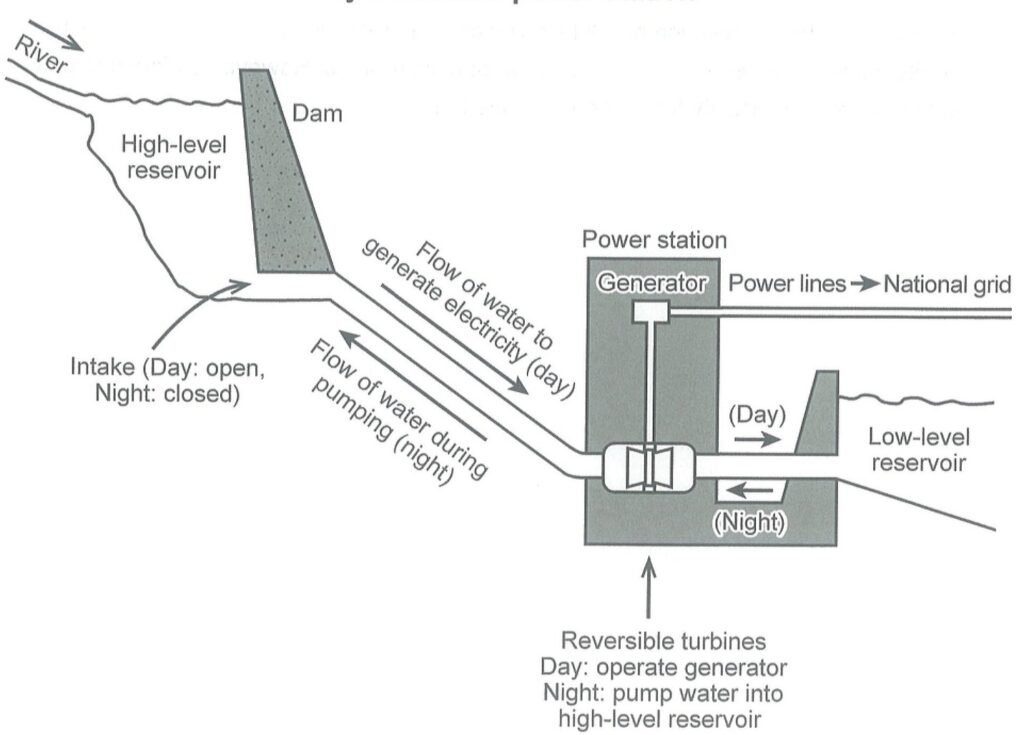Writing Task 1
You should spend about 20 minutes on this task.
The diagram below shows how electricity is generated in a hydroelectric power station.
Summarise the information by selecting and reporting the main features, and make comparisons where relevant.
Write at least 150 words.
Hydroelectric Power Station

Writing Task 2
You should spend about 40 minutes on this task.
Write about the following topic:
Some people say that music is a good way of bringing people of different cultures and ages together.
To what extent do you agree or disagree with this opinion?
Give reasons for your answer and include any relevant examples from your own knowledge or experience.
Write at least 250 words.
Cambridge IELTS 14 Academic Writing Test 3 Task 1 Model Answer (151 words)
The diagram illustrates the process of electricity generation in a hydroelectric power station, highlighting both daytime and nighttime operations.
During the day, water from a high-level reservoir flows through an open intake, driving turbines in the power station. These turbines generate electricity, which is then transmitted to the national grid via power lines. This process efficiently converts the potential energy of stored water into electrical energy.
At night, the intake is closed, and the turbines operate in reverse as pumps. They move water from a low-level reservoir back to the high-level reservoir. This pumping action uses excess electricity from the grid, effectively storing energy for future use.
This cyclical process ensures a balanced and efficient energy supply, utilizing high demand periods for electricity generation and low demand periods for energy storage. The reversible turbines play a crucial role in maintaining this balance, making hydroelectric power a versatile and sustainable energy source.
Cambridge IELTS 14 Academic Writing Test 3 Task 2 Model Answer (271 words)
Music is often seen as a universal language that can bridge cultural and generational divides. I agree with the view that music brings people of different cultures and ages together. Here are a few reasons why.
Firstly, music evokes emotions that are universally understood. A powerful symphony or a catchy pop song can move people regardless of their background. For example, Beethoven’s symphonies or modern pop hits can resonate with listeners worldwide, creating a shared emotional experience.
Secondly, music festivals and concerts are great platforms for cultural exchange. Events like Glastonbury or Coachella attract diverse audiences, allowing people to experience different musical styles and cultures. The WOMAD festival, for instance, celebrates global music and brings together artists and audiences from various backgrounds.
Moreover, music education promotes cultural awareness. By learning about different musical traditions, students can appreciate other cultures. This can help break down cultural barriers and foster respect for diversity. For example, incorporating African drumming or Indian classical music into school curriculums can expose students to new perspectives.
Additionally, music can bridge generational gaps. Songs from past decades often make comebacks, allowing older and younger generations to connect over shared musical interests. The resurgence of vinyl records, for example, has brought classic rock and jazz back into the spotlight, enabling parents and children to bond over these genres.
In conclusion, music is a powerful tool for uniting people across cultures and ages. Its ability to evoke emotions, create shared experiences, and serve as a platform for cultural exchange makes it an effective means of fostering unity and understanding. By embracing music, we can build a more inclusive and harmonious world.
Leave a Reply